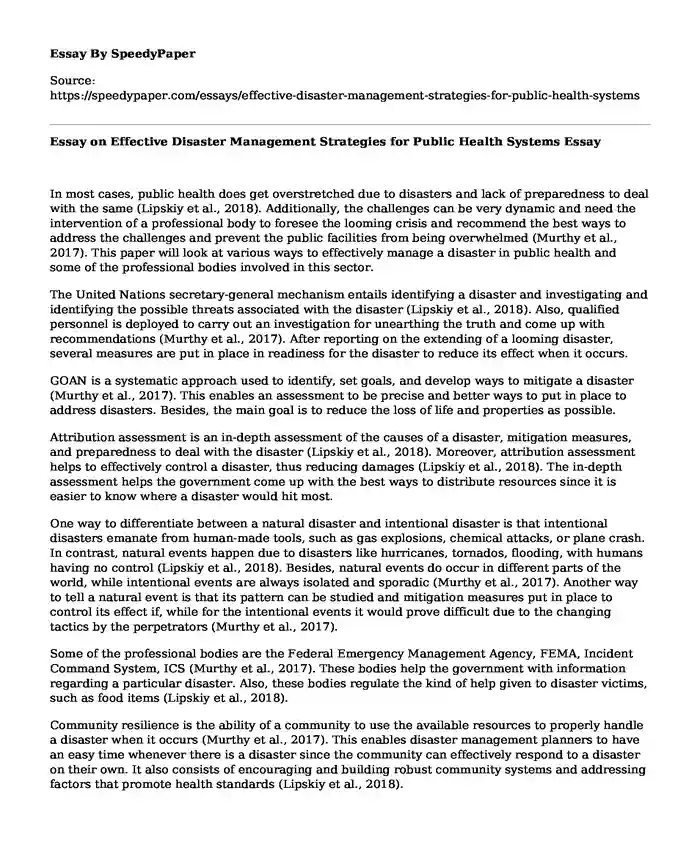
| Type of paper: | Essay |
| Categories: | Management Medicine Healthcare Disaster |
| Pages: | 3 |
| Wordcount: | 760 words |
In most cases, public health does get overstretched due to disasters and lack of preparedness to deal with the same (Lipskiy et al., 2018). Additionally, the challenges can be very dynamic and need the intervention of a professional body to foresee the looming crisis and recommend the best ways to address the challenges and prevent the public facilities from being overwhelmed (Murthy et al., 2017). This paper will look at various ways to effectively manage a disaster in public health and some of the professional bodies involved in this sector.
The United Nations secretary-general mechanism entails identifying a disaster and investigating and identifying the possible threats associated with the disaster (Lipskiy et al., 2018). Also, qualified personnel is deployed to carry out an investigation for unearthing the truth and come up with recommendations (Murthy et al., 2017). After reporting on the extending of a looming disaster, several measures are put in place in readiness for the disaster to reduce its effect when it occurs.
GOAN is a systematic approach used to identify, set goals, and develop ways to mitigate a disaster (Murthy et al., 2017). This enables an assessment to be precise and better ways to put in place to address disasters. Besides, the main goal is to reduce the loss of life and properties as possible.
Attribution assessment is an in-depth assessment of the causes of a disaster, mitigation measures, and preparedness to deal with the disaster (Lipskiy et al., 2018). Moreover, attribution assessment helps to effectively control a disaster, thus reducing damages (Lipskiy et al., 2018). The in-depth assessment helps the government come up with the best ways to distribute resources since it is easier to know where a disaster would hit most.
One way to differentiate between a natural disaster and intentional disaster is that intentional disasters emanate from human-made tools, such as gas explosions, chemical attacks, or plane crash. In contrast, natural events happen due to disasters like hurricanes, tornados, flooding, with humans having no control (Lipskiy et al., 2018). Besides, natural events do occur in different parts of the world, while intentional events are always isolated and sporadic (Murthy et al., 2017). Another way to tell a natural event is that its pattern can be studied and mitigation measures put in place to control its effect if, while for the intentional events it would prove difficult due to the changing tactics by the perpetrators (Murthy et al., 2017).
Some of the professional bodies are the Federal Emergency Management Agency, FEMA, Incident Command System, ICS (Murthy et al., 2017). These bodies help the government with information regarding a particular disaster. Also, these bodies regulate the kind of help given to disaster victims, such as food items (Lipskiy et al., 2018).
Community resilience is the ability of a community to use the available resources to properly handle a disaster when it occurs (Murthy et al., 2017). This enables disaster management planners to have an easy time whenever there is a disaster since the community can effectively respond to a disaster on their own. It also consists of encouraging and building robust community systems and addressing factors that promote health standards (Lipskiy et al., 2018).
Challenges faced in disaster preparedness can finances. Sometimes the government or the community may not have the required funds to set up the infrastructure for disaster preparedness (Lipskiy et al., 2018). Furthermore, a state or a community may not have the capacity to identify and address the looming disasters, making it difficult to identify areas for improvement (Murthy et al., 2017). Another challenge is people not adhering to the set rules and regulations for instance in case of a perennial flood, people may be advised to move from the flood-prone areas and move to the higher grounds, but some people can ignore and still settle in such areas (Lipskiy et al., 2018).
In conclusion, public health emergency management is a vital factor in preserving the lives of the people. Sometimes, a disaster can happen that is huge, and that requires better healthcare facilities to handle the situations. However, some of these disasters can be averted if a robust team is put in place to identify possible disasters and recommend better mitigation measures to reduce the impact.
References
Lipskiy, N., Tyson, J., & Burkholder, J. (2018). Developing Semantically Interoperable PH Emergency Preparedness Data Exchange. Online Journal of Public Health Informatics, 10(1). https://www.ncbi.nlm.nih.gov/pmc/articles/PMC6087991/
Murthy, B. P., Molinari, N. A. M., LeBlanc, T. T., Vagi, S. J., & Avchen, R. N. (2017). Progress in public health emergency preparedness—the United States, 2001–2016. American journal of public health, 107(S2), S180-S185. https://ajph.aphapublications.org/doi/full/10.2105/AJPH.2017.304038
Cite this page
Essay on Effective Disaster Management Strategies for Public Health Systems. (2023, Oct 14). Retrieved from https://speedypaper.net/essays/effective-disaster-management-strategies-for-public-health-systems
Request Removal
If you are the original author of this essay and no longer wish to have it published on the SpeedyPaper website, please click below to request its removal:
- Euthanasia Essay Sample - The Helen Scott's Case
- Essay Example: Aid Organization Report
- Paper Example. The Issue of Anxiety and Depression in Higher Education Institutions
- Scenario and Events - Essay Example
- Essay Example - Misinformation and Disinformation Concerning Coronavirus
- Covid-19 and Education - Free Report Sample
- Essay Sample on Effective Project Management: Block's Six Steps to Stakeholder Success
Popular categories




